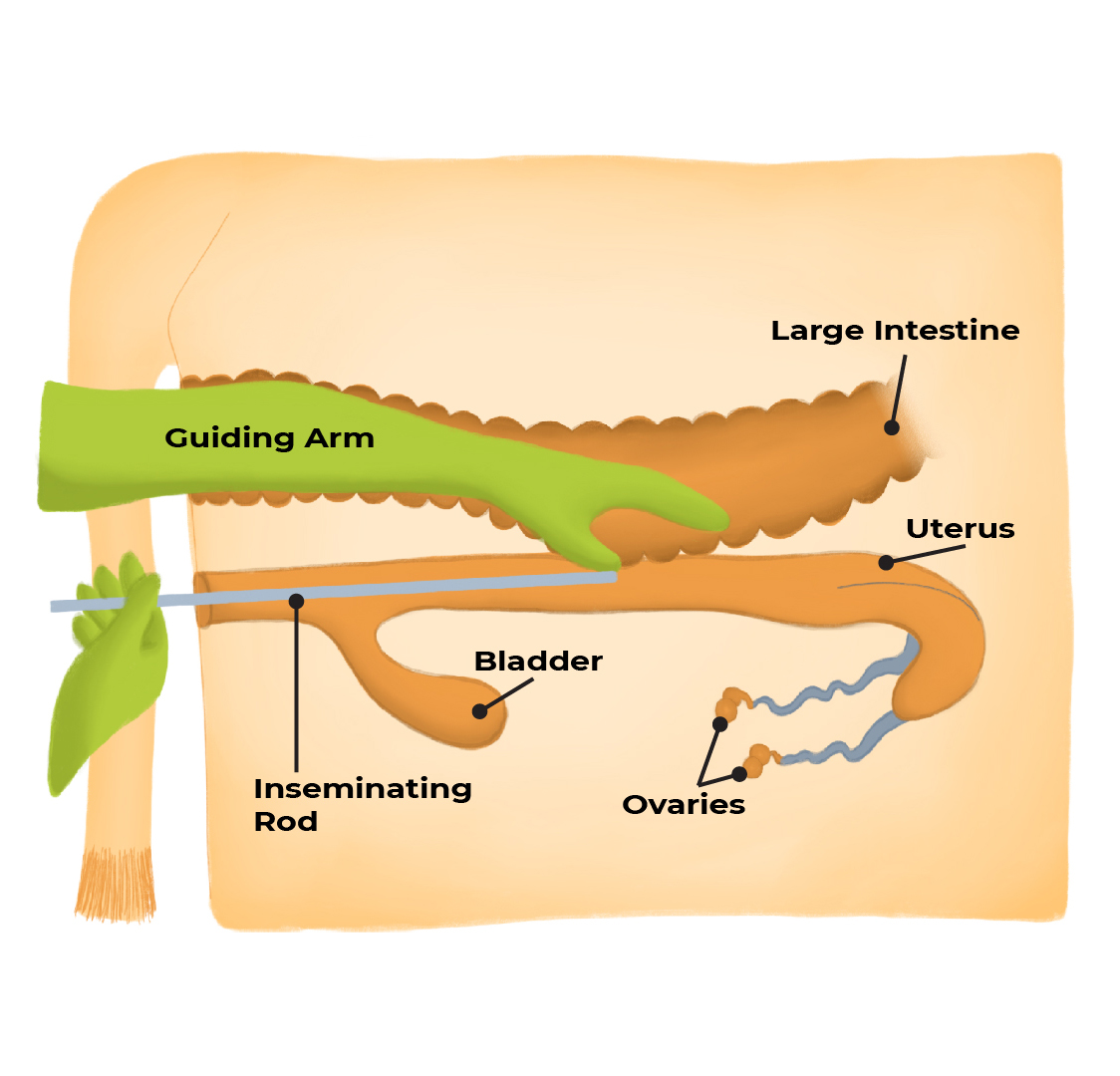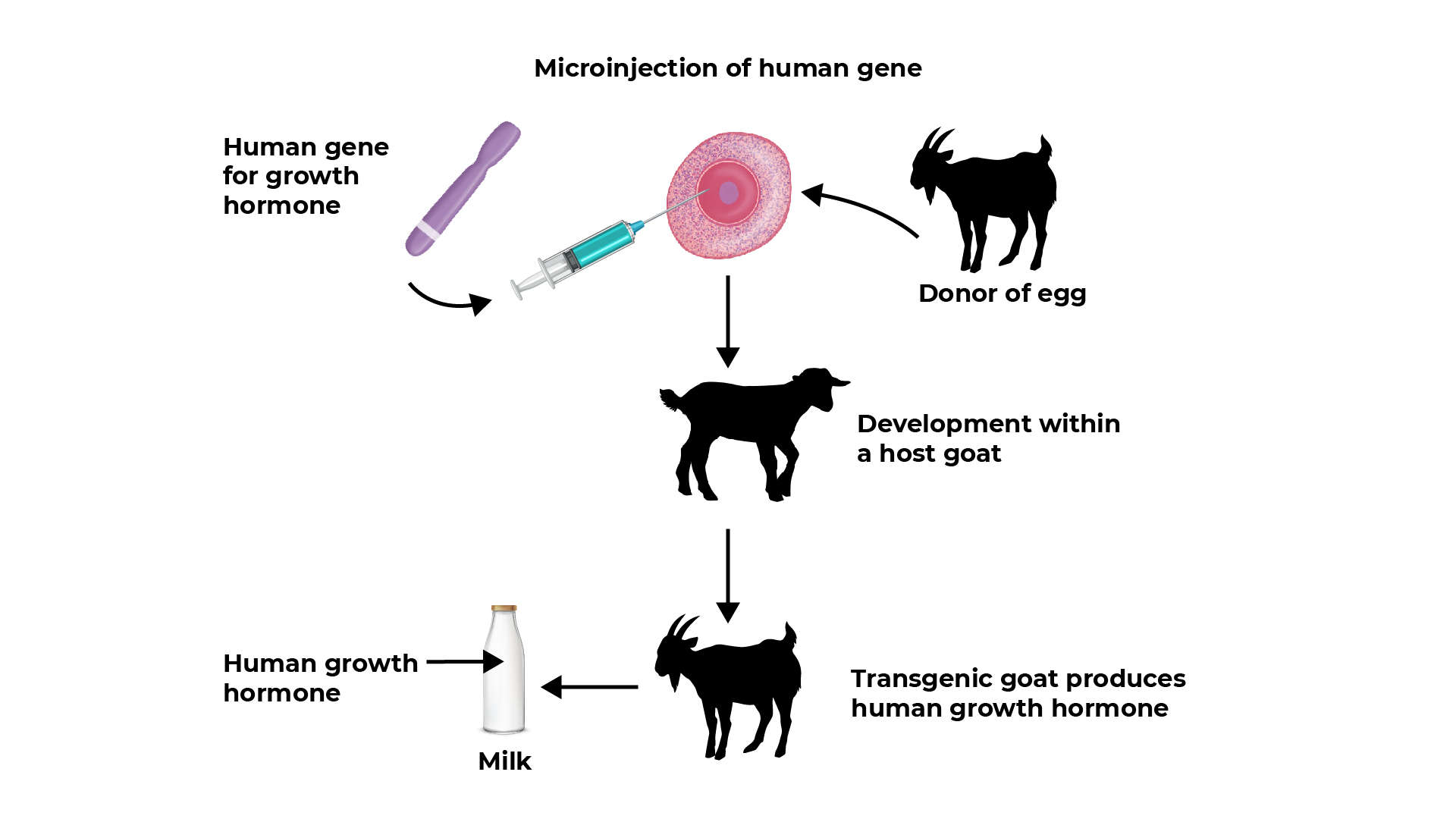9. Reproductive Technologies
By the end of this session you will be able to:
- Describe and explain the process of synchronization of oestrus
- Explain the process of artificial insemination
- Evaluate the role of sexed semen and embryos
- Describe what is meant by cloning, embryo transfer and transgenesis
- Describe and explain the various methods of pregnancy diagnosis.
Introduction
Reproduction, which is the production of an offspring, is fundamental to the majority of farm systems.
Getting the cow back in calf, getting the sheep flock in lamb, or the production of chicks to lay eggs or to produce meat is the main focus of a farmer.
Naturally, animals would mate in the wild, however as we have domesticated our farm animals, their reproduction comes under the control of the farmer.
The farmer has the choice of the ways in which they impregnate their females and also which technologies, if any, they choose to use.
Synchronization of oestrus
Oestrus is the period in a female’s reproductive cycle where she is said to be ‘on heat’, or receptive to be mated.
This period of oestrus can be synchronised, in order for all the females to reproduce together, over a short period of time.
This has many advantages...
Can you think of any?
Control of the oestrus cycle
The control of the oestrous cycle is dependent on manipulating the hormones involved in the cycle. There are two methods of controlling the oestrous cycle which are the:
a) induction of luteolysis
b) simulation of the luteal phase.
a) Induction of luteolysis (the breaking up of the corpus luteum)
This is achieved by the intramuscular injection of prostaglandin (PGF) during the mid-luteal phase of the cycle which will result in premature luteolysis and lead to the fall in the progesterone level.
The fall of progesterone to basal level will take approximately 30 hours after the administration of the injection. The fall in progesterone will allow GnRH to be activated, which will be followed by the secretion of FSH and LH from the anterior pituitary gland, and the cow will come into heat in 3 to 4 days’ time.
However, for this to work, there must be a corpus luteum present in the ovary, and the corpus luteum is only sensitive to PGF between day 5 and 17 of the cycle.
A rectal examination needs to be carried out to determine if there is a corpus luteum present and also to make sure that the animal is not pregnant. If PGF is injected into a pregnant animal of less than 150 days or more than 250 days, it is highly likely that she will abort.
Prostaglandins
These injections can be used in many ways:
- Total Synchronization of a group of heifers
- Injecting cows which have not been seen bulling
- Injecting cows which are not in sync with the rest of the group.

b) Simulation of the luteal phase
This is achieved by the administration of progesterone or one of its derivatives.
The aim is to administer a source of progesterone that has a longer lifespan than the corpus luteum.
The administered progesterone is acting like an artificial corpus luteum and treated animals will not come on heat until the source is removed.
PRID - Progesterone-Releasing Intravaginal Device.
This is a specialised implant that is inserted by a special applicator into and held within the animal's vagina for a period of up to 12 days. The PRID is composed of a flexible stainless steel coil covered in a silicone rubber coating into which progesterone is impregnated.
The progesterone blocks the GnRH activity, the corpus luteum regresses naturally but the animal will not come on heat because no FSH and LH are released.
On day 12, the PRID is removed.

CIDR: Controlled Internal Drug Release
Consists of a nylon T-shaped structure covered by a progesterone impregnated silicone with a small plastic tail which is left protruding from the vulva. On removal of the CIDR, a prostaglandin injection is often administered, and the cow comes on heat within 3 to 4 days after the removal of the CIDR.

Crestar
This is a progesterone implant placed under the skin behind the ear of the animal. At the same time, an intra-muscular injection of oestradiol is administrated, which helps to remove any remaining corpus luteum. After 9 to 10 days, a small scalpel cut is made in the overlying skin and the implant is squeezed out.
The cow comes on heat 48 hours after the removal of the implant.

Synchronization of oestrus in sheep
There are 2 main methods:
- Using hormones implanted into the ewe.
- Using a teaser ram, which is a vasectomised ram.
Sponging ewes
What is sponging?
The sponge contains the progesterone hormone; this hormone sends a message to the brain so that the sheep doesn’t come into heat.
The process takes up to 2 weeks (14 days).
After the progesterone sponge has been removed on the 12th day, you should inseminate the ewe 52hrs later.

How does sponging work?
- Day 1. Insert progesterone sponge.
- Day 3. Inject the ewe with estrumate.
- Day 12. Remove sponge.
- Day 13. Introduce teaser ram, this helps to synchronise ewes to come into heat at the same time.
- Day 14. Inseminate ewes 10-18 hours after ewe has been in with teaser ram.

Teaser Ram
What is a teaser?
A teaser ram is an infertile ram; they are used to bring ewes into heat at the same time so that they can be sent to the fertile rams.
A teaser ram will mount the ewe but will not impregnate her.
The teaser has testosterone on him; this is the scent that brings the ewes into heat.

How does a teaser ram synchronise ewes?
- Day 1 – Inject estrumate (150mg) Intramuscular.
- Day 10 – Inject estrumate.
- Day 11 – Introduce teaser ram.
- Day 12-14 – Inseminate ewe 10-12hrs after ewe has been in with the teaser.
- Heat lasts 18-36hrs but fertility decreases each hour.
- Day 27-30 – Watch for teaser marks and inseminate.
Rams can be fitted with a harness This then shows you which females the ram has mounted and there’s a possibility of the ewe being inseminated.

Natural Service vs Artificial Reproduction
Natural service
The bull mounts the cow, which stands to be mounted.
Semen is ejaculated, as a result of a peristalsic movement from the epididymis, along the vas deferens to the urethra, and ultimately to the vagina just posterior to the cervix, which is the entrance to the uterus.

Artificial Insemination (AI)
The bull with each ejaculation, provides enough semen, after dilution, to make at least 500 straws, with each individual straw of 0.25ml containing 20 million spermatozoa.
This is collected and made into ‘straws’ of semen which is stored in liquid nitrogen.
Just before insemination, the technician will thaw out the straw and place it into a long injector.

Timing of AI
The timing is critical and 12 – 24hrs after ‘standing heat’ would appear to be ideal.
The semen is thawed, and introduced into the cow’s tract using a suitable ‘gun’. The semen is injected into the uterine body, just the other side of the cervix.

Task
In pairs, discuss the potential advantages of using AI in cattle.
Advantages to using AI
- Access to the best bulls in the world without having to own them.
- Wider choice.
- Less disease risk than hiring a bull in to serve your cows.
- No need to pay to keep a bull.
- Less danger.
Sexed semen and sexed embryos
Semen having X- or Y- bearing sperm to produce progenies of a desired sex either female or male (with about 80-90% accuracy) is known as sexed semen.

The ability to use sexed semen in vitrio (in a test-tube) to fertilise a number of eggs from prolific females, makes it more likely to have sexed embryos to insert in to a waiting recipient.
Embryos can also be flushed from donor females and inserted into waiting recipients to speed up and multiply genetic gain within a herd or flock.
Cloning
Cloning is the process of producing individuals with identical or virtually identical DNA, either naturally or artificially.
Cells containing donor DNA replace the recipients’ DNA in the nuclei of an emptied blastocysts (fused egg and sperm), thereby giving rise to a new embryo.

Dolly, the world’s first cloned sheep.

© National Human Genome Research Institute
Embryo transfer
Embryo transfer is the process by which fertilised embryos are flushed (removed) from a donor ewe and then transplanted into suitably synchronised recipient ewes to establish a surrogate pregnancy.
The embryo begins to implant about 10 days after surgery.
Transgenesis
Transgenesis is the process of introducing a gene (referred to as a transgene) from one organism into the genome of another organism. The aim is that the resulting transgenic organism will express the gene and exhibit some new property or characteristic.
The example on the left shows how a goat could be made to produce milk with human growth hormones, which could help children with stunted growth.

Methods of Pregnancy Diagnosis in Farm Animals
There are three basic methods: -
1. The 24-day milk Progesterone test - This test measures progesterone levels in the milk. It is a good test to show if a cow is not in calf. False positives however are possible, in cases where fertilization has not occurred, but the life of the corpus luteum is prolonged for any reason.
2. Rectal palpation - This is not possible until the 35th day of a pregnancy. The uterus is felt by inserting the hand into the rectum, and the difference between an empty and a pregnant uterus detected.
3. Ultra sound scanning - The scanner consists of a probe, which is inserted into the cow’s rectum, and scans over each horn of the uterus. The screen represents a black and white picture of the uterus, the wall being light and the fluids dark.

Conclusion
At the end of this session you should be able to:
- Describe and explain the process of synchronization of oestrus.
- Explain the process of artificial insemination.
- Evaluate the role of sexed semen and embryos.
- Describe what is meant by cloning, embryo transfer and transgenesis.
- Describe and explain the various methods of pregnancy diagnosis.